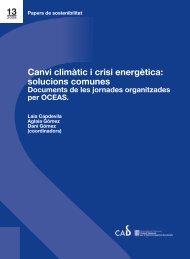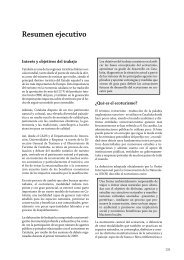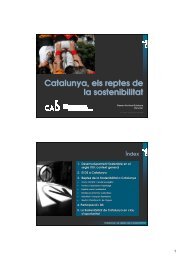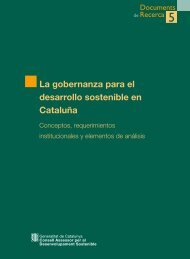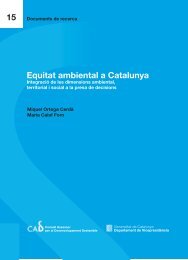Estratègies per al desenvolupament sostenible - Generalitat de ...
Estratègies per al desenvolupament sostenible - Generalitat de ...
Estratègies per al desenvolupament sostenible - Generalitat de ...
Create successful ePaper yourself
Turn your PDF publications into a flip-book with our unique Google optimized e-Paper software.
7. The Financi<strong>al</strong> Basis of the StrategiesNo strategy for sustainable <strong>de</strong>velopment can succeed without financi<strong>al</strong> backing.This is borne out by the ex<strong>per</strong>ience of Agenda 21, which lost credibility as thegap between what was required and what was available became more apparent.The pronouncements and programmes of Agenda 21, though individu<strong>al</strong>lyreasonable and compelling, when taken together and without a reference tosources of financing, appear little more than a wish list of things good to havebut beyond our reach 15 . In earlier strategies “finance” tasks were often limitedto adding up the cost of recommen<strong>de</strong>d actions and proposing increases in thegovernment budget. While it is important to mobilize finance for a sustainable<strong>de</strong>velopment strategy, in particular to get the formulation process started, thisis not sufficient. As the concept of a sustainable <strong>de</strong>velopment strategy hasmoved away from a focus on producing a plan document (often containing oraccompanied by a suite of proposed projects) to a more process-orientedapproach, so the financi<strong>al</strong> ch<strong>al</strong>lenges have changed.It is no longer simply a case of mobilizing funds for such projects or activities,with the government in the lead implementing role. A strategy is now seen asbeing more about setting a vision with broad directions, agreeing the attributesof a path towards sustainable <strong>de</strong>velopment, and putting in place the keymechanisms. So attention must be given <strong>al</strong>so to the financi<strong>al</strong> mechanismsnee<strong>de</strong>d to intern<strong>al</strong>ise environment<strong>al</strong> and soci<strong>al</strong> costs in or<strong>de</strong>r to achieve thenecessary changes in direction. Responsibility still lies primarily with governmentto introduce the required measures, but the aim is <strong>al</strong>so to change financi<strong>al</strong>behaviour, particularly within the private sector; for example, to make pollutersand beneficiaries of environment<strong>al</strong> services pay.In its “Five Years after Rio” Report, the World Bank highlighted the need toremove <strong>per</strong>verse subsidies, impose environment<strong>al</strong> taxes and apply more a<strong>de</strong>quateuser charges as policy instruments that could ensure financi<strong>al</strong> sustainability.These instruments can be complemented by a range of others that can strengthenthe financi<strong>al</strong> base for sustainable <strong>de</strong>velopment strategies: for example, markets15 Panayotou, T (1994), Financi<strong>al</strong> Mechanisms for Agenda 21 (or How to Pay for SustainableDevelopment), Harvard Institute for Internation<strong>al</strong> Development, Massachusetts. 173




